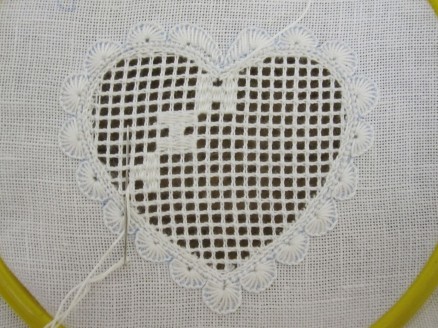In several of my books I showed many different filling patterns and described, in detail, the steps of working. In contrast to the surface filling patterns presented in Early Schwalm Whitework, all the numbered patterns are withdrawn thread filling patterns.
There are:
10 filling patterns in “Basic Principles of Schwalm Whitework”
68 in “Limetrosen I”
84 in “Wickelstiche I” (actually 85, but 1 is also listed in BPSW)
79 in “Limetrosen II”
26 in “Openwork Pattern Samplers”, and finally
174 in “Openwork Needleweaving Patterns” (actually 175, but 1 is also listed in BPSW).
That makes
441 unique filling patterns in all!
But there are even more nice filling patterns (simple drawn thread, Limet, or Openwork).
In my books, excluding the Sampler book, I only presented patterns that used a single Schwalmtypical embroidery stitch. However, Schwalm Whitework gets its wealth by the innumerable ways to combine those single stitches.
Should one use Rose stitches, Needleweaving and a combination of both for Openwork patterns, the variety of stitch combinations for Limet patterns is nearly inexhaustible. Here are some possible combinations:
Rose stitches and Four-Sided stitches
- Rose stitches and Satin stitches
- Rose stitches, Four-Sided stitches and Satin stitches
- Satin stitches and Four-Sided stitches
- Satin stitches and Wave stitches
- Satin stitches and Square stitch variation
- Rose stitch and Single Faggot
- Single Faggot and Diagonal Cross Filling
- Satin Stitch and Square Eyelet
- Rose stitch and Square Eyelet
- Rose stitch and Satin stitch
- Single Faggot, Diagonal Cross Filling and Rose stitch
- Honeycomb Darning stitch and Rose stitch
And all of these combinations may be variously arranged – straight or diagonally, in diagonal steps or put together in squares or rhombi.
I think it might be possible to glean about 1000 different patterns; let me give it a stab.
Now and then I will present one more filling pattern.
Here is the first. It is an easy-to-work pattern and it is called No. 442 (“H” pattern). It would be difficult to find a real name for each pattern and so some will only be called by a number.
No. 442 (“H” pattern)
category: Openwork pattern with Cable stitch grid
stitches used: Needleweaving over 1 and 3 squares; changing the direction
center: square
positive pattern to No. 443
 Starting in the middle, always alternate withdrawing and leaving two vertical threads. Do the same with the horizontal thread; it is best to start below the concave point of the heart (upper point). The established grid is stabilized with Single Faggot stitches – which is simply Cable stitch from the front – worked from the back side of the fabric.
Starting in the middle, always alternate withdrawing and leaving two vertical threads. Do the same with the horizontal thread; it is best to start below the concave point of the heart (upper point). The established grid is stabilized with Single Faggot stitches – which is simply Cable stitch from the front – worked from the back side of the fabric.
 Starting at the concave point (the middle of the motif), the pattern will be woven in a stair-step manner. You will notice how the direction of the weaving changes with each “H”.
Starting at the concave point (the middle of the motif), the pattern will be woven in a stair-step manner. You will notice how the direction of the weaving changes with each “H”.
 One diagonal pattern row is worked to the next until the entire shape is filled.
One diagonal pattern row is worked to the next until the entire shape is filled.
 Washed, starched and ironed the finished pattern shows its charm.
Washed, starched and ironed the finished pattern shows its charm.
 Worked within a wider shape, shown here in the heart-design of a lampshade, the effect of the pattern can develop better.
Worked within a wider shape, shown here in the heart-design of a lampshade, the effect of the pattern can develop better.
If you require more detailed instructions, e.g., preparing the pattern areas, withdrawing the threads, or working specific stitches, please refer to my book “Basic Principles of Schwalm Whitework”.
Another 175 Needleweaving patterns can be found in my book “Openwork Needleweaving Patterns”.



Wunderbar Luzine! ich liebe alle das Photos so wir kann die Schritt sehen. das Photo mit ein leicht hinter ist super!
Liebe Grüße,
Kathy
Ich möchte gern mit das Schwalmer sticken anfangen. Dank dieser Blog bin ich noch mehr begeistert von das biesondere Schwalmer Stickerei. Erst mahl ein gutes Linen suchen und dann an die Arbeit…*Ü*…
Vielen dank für die schone und deutliche Photos…
Liebe Grüsse,
Willeke
P.S. Ich entschuldige mich für die Fehler im Deutsch schreiben.
Ja, Willeke, wenn man das richtige Material hat und mit einem nicht zu großen Projekt beginnt, hat man viel Freude an der Schwälmer Weißstickerei.
Ich wünsche gutes Gelingen
Luzine